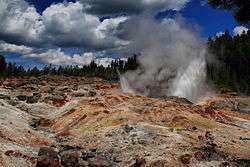Steamboat Geyser
Steamboat Geyser, in Yellowstone National Park's Norris Geyser Basin, is the world's tallest currently-active geyser. Steamboat Geyser has two vents, a northern and a southern, approximately 20 feet (6.1 m) apart. The north vent is responsible for the tallest water columns; the south vent's water columns are shorter.[3]
| Steamboat Geyser | |
|---|---|
 Major eruption, Steamboat Geyser, circa 1960s | |
| Location | Norris Geyser Basin, Yellowstone National Park, Park County, Wyoming |
| Coordinates | 44°43′25″N 110°42′11″W[1] |
| Elevation | 7,598 feet (2,316 m)[2] |
| Type | Cone geyser |
| Eruption height | 300 to 400 feet (91 to 122 m) |
| Frequency | 3 days to 50 years |
| Duration | 3 to 129 minutes |
| Temperature | 71.3 °C (160.3 °F) on 1998-06-26[1] |
Norris Geyser Basin | |
Prior to 1904, Waimangu Geyser, in New Zealand, had some taller eruptions capable of reaching 1,600 feet (490 m), but in 1904, a landslide changed the local water table, and since then, Waimangu has not erupted.[4] Excelsior Geyser in Yellowstone's Midway Geyser Basin, and Semi-Centennial Geyser just north of Roaring Mountain on the Grand Loop Road were reported to be as tall as Steamboat, both with eruptions reaching 300 ft (91 m).[5] However, Excelsior has not erupted since 1985, and now functions as a hot spring, and Semi-Centennial's one eruption of this height was reported in 1922 and has been dormant since.
Steamboat's major eruptions generally last from 3 to 40 minutes (a couple of durations surpassing an hour were observed during the 2018 active phase[6]), and are followed by powerful jets of steam. During these eruptions, water may be thrown more than 300 feet (91 m) into the air.[7] Steamboat does not erupt on a predictable schedule, with recorded intervals between major eruptions ranging from three days to fifty years. The geyser was dormant from 1911 to 1961. In 2018-2019, the geyser entered a prolonged period of frequent activity with more than 40 eruptions reported in a one-year period.
Minor eruptions of 10 to 15 feet (3.0 to 4.6 m) are much more frequent.
After an eruption, the geyser often vents large amounts of steam for up to 48 hours.[8] Sometimes during this part of an eruption, water may return to Steamboat, causing it to jet water once again, though to lesser heights.[6] Cistern Spring, located nearby, will drain completely following a major eruption of the geyser; the spring refills within a few days.
Recent eruptions and active phase of 2018-2019
The most recent eruption of Steamboat Geyser occurred on June 23, 2020. In 2019 the 48th eruption for the year occurred on December 26th and this set a new annual number for eruptions.[9] This was the 102nd eruption since it re-activated in early-2018.[10]
Many years may pass between eruptions, but in some years multiple eruptions have occurred. In 1964, twenty-nine eruptions were reported.[11] Eruptions from 1990 to 2018:
- June 4, 1990
- October 2, 1991 - (1 year 120 days)
- May 2, 2000 - (8 years 213 days)
- April 26, 2002 - (1 year 359 days)
- September 13, 2002 - (140 days)
- March 26, 2003 - (194 days)
- April 27, 2003 - (32 days)
- October 22, 2003 - (178 days)
- May 23, 2005 - (1 year 213 days)
- July 31, 2013 - (8 years 212 days)[11]
- September 3, 2014 - (1 year 34 days)
Active phase since 2018

In 2018, Steamboat Geyser entered a much more active period with 102 eruptions recorded between March 15, 2018 and June 23, 2020. [12][6][13] Thirty-two eruptions occurred in 2018 and 48 occurred 2019. This broke 1964's record of 29 eruptions within a calendar year.[14] The 2018 record was broken on August 27, 2019 with the 33rd major eruption of the year.[15]
| Steamboat Geyser eruptions of the 2018-2020 active phase | |||
|---|---|---|---|
|
|
|
|
Gallery
 Major eruption on May 23, 2005
Major eruption on May 23, 2005 Major eruption on May 23, 2005
Major eruption on May 23, 2005 Steam venting on May 24, 2005
Steam venting on May 24, 2005 Minor eruption June 22, 2008
Minor eruption June 22, 2008
References
- "Steamboat Geyser". Yellowstone Geothermal Features Database. Montana State University.
- "Steamboat Geyser". Geographic Names Information System. United States Geological Survey.
- Jones, Janet. "Watching Steamboat Geyser". Retrieved June 25, 2019.
- Jones, Gregory L. "Tall Geysers". WyoJones' Geyser Pages. Retrieved May 24, 2006.
- "Yellowstone Celebrates With a New Geyser". National Parks Magazine (30). November 8, 1922. Retrieved April 12, 2019.
- Various observers. "Steamboat Geyser". GeyserTimes.org. Retrieved August 29, 2018.
- Bryan, T. Scott (May 1995). The Geysers of Yellowstone (3rd ed.). University Press of Colorado. ISBN 0-87081-365-X.
- "Steamboat Geyser". National Park Service.
- "World's tallest geyser breaks eruption record". USA Today. Retrieved 2019-12-24.
- "Steamboat Geyser". GeyserTimes.com. Retrieved 2019-12-24.
- "Steamboat Geyser" (PDF). National Park Service. August 2013. Retrieved 2016-04-18.
- "Steamboat Counter". Yellowstone Volcano Observatory. May 14, 2018. Retrieved August 29, 2018.
- "Steamboat Geyser". National Park Service. Retrieved November 29, 2018.
- Michael Poland (January 2, 2019). "Yellowstone Volcano Monthly Update". Yellowstone Volcano Observatory. Retrieved January 5, 2019. (raw text)
- "Eruption Detail". GeyserTimes. Retrieved 2019-08-27.
- "Yellowstone's Steamboat Geyser erupts for 5th time this year". The Washington Post. May 13, 2018. Retrieved May 13, 2018.
- "Steamboat Geyser in-basin report September 12, 2018". GeyserTimes.org. September 12, 2018. Retrieved September 12, 2018.
- "Seismogram Reporting Wrapper (YNM SHZ WY 01)". isthisthingon.org. September 12, 2018. Retrieved September 12, 2018.
